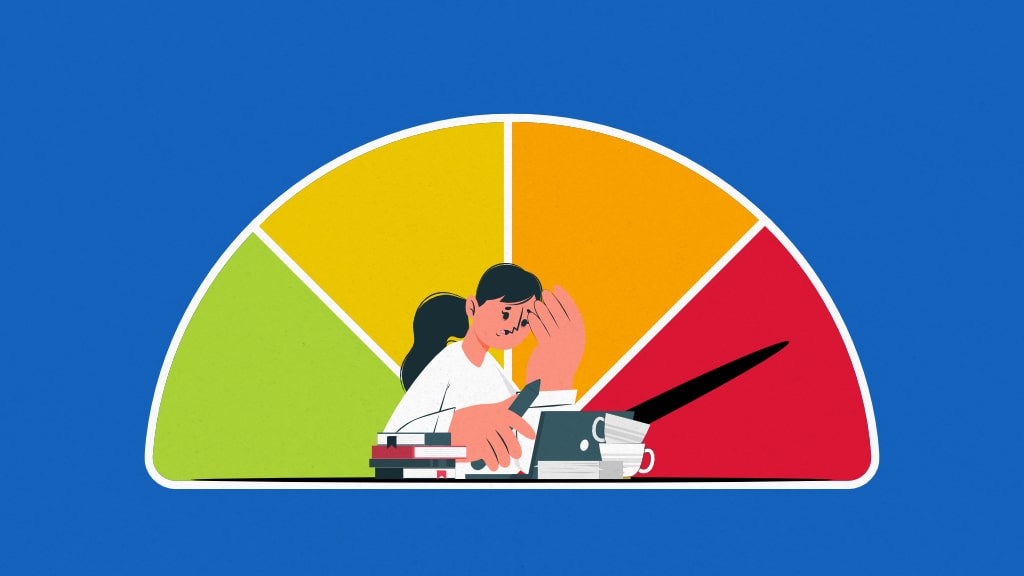Introduction
Ever feel like your job is draining the life out of you? Or Are you a manager noticing your team running on empty and lacking motivation?
If so, then it’s very likely that you or your team are a victim of work burnout.
Not too long ago, you were crushing it at work and still having fun. But now, exhaustion, zero motivation, and constant stress hit you out of nowhere, and your performance is taking a hit.
It’s worrying because the feeling of ‘I have nothing more to give’ is debilitating and requires immediate attention.
Considering that close to 82% of employees will be exposed to burnout risk in 2025, addressing the burnout epidemic will become even more crucial.
In this article, we’ll dive into how to prevent burnout and recover from it.
We’ll also break down its causes, signs, and all the details. But first, let’s get a clear understanding of what burnout is and its different types.
What is work burnout?
Work burnout is chronic job stress that manifests in the form of physical, mental, and emotional exhaustion.
World Health Organization (WHO) defines work burnout in the 11th Revision of the International Classification of Diseases (ICD-11) as –
“Burn-out is a syndrome conceptualized as resulting from chronic workplace stress that has not been successfully managed. It is characterized by three dimensions:
- Feelings of energy depletion or exhaustion;
- Increased mental distance from one’s job, feelings of negativism or cynicism related to one’s job, and
- Reduced professional efficacy
Burn-out refers specifically to phenomena in the occupational context and should not be applied to describe experiences in other areas of life.”
So, if you think work burnout syndrome is a personal issue or any medical diagnosis, then you are highly mistaken. It is completely a workplace phenomenon.
3 types of work burnout
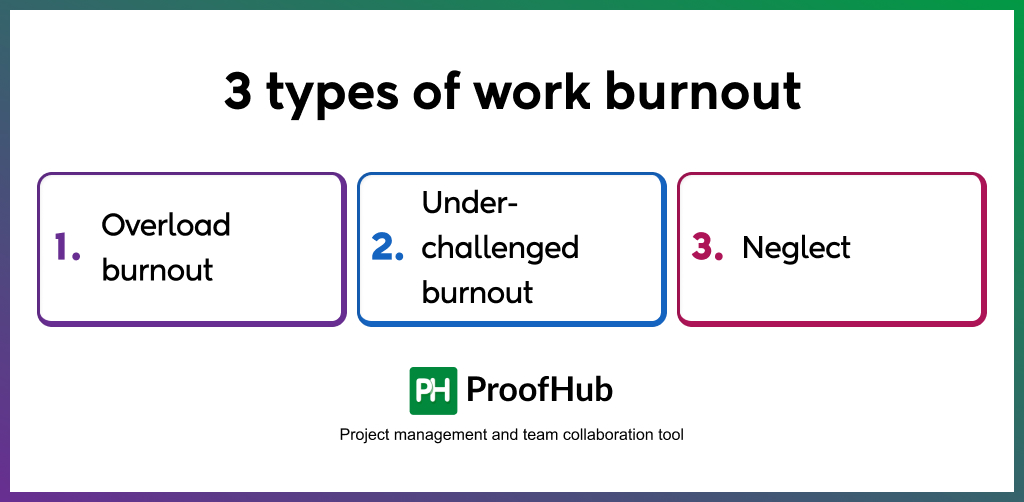
Here’s a breakdown of work burndown types:
1. Overload burnout
Overload burnout is when you push yourself too hard to a limit where the finish line seems blurred. You stretch your work hours beyond sustainable limits, and it is the most common pathway through which people see burnout. The motivation behind grinding relentlessly can be anything – appreciation, promotion, increment, recognition, and even success. But, no matter how intentional you are, it can be detrimental in the long run.
Prioritize your tasks effectively with the best work prioritization tools to prevent overload burnout
2. Under-challenged burnout
The extent to which lack of stimulation can affect you is nothing less overwhelming when compared to an extra workload. This is in total contradiction with the former, as here, you will struggle to find growth opportunities. You may start to feel bored, unmotivated, disconnected, or even under-challenged at work. Work feels monotonous and uninspiring to the extent that you tend to avoid your responsibilities.
3. Neglect
When you start to feel helpless and unsupported at work, you are experiencing neglectful burnout. You start to doubt your abilities, potential, and worth as you see nothing going right for yourself. You feel incompetent as nothing that you do makes any difference. While it is easy to doubt yourself here, it isn’t your fault. It’s your workplace that has failed to bring clear expectations, support, and, most importantly, motivation to the table.
Signs and symptoms of work burnout

Burnout isn’t diagnosable but does possess signs and symptoms. The manifestations and severity vary from person to person.
Here are a few indicators to look out for:
- Insomnia
- increased irritability
- Decreased productivity
- Chronic fatigue
- Lack of motivation
- Self-doubt
- Acute stress
- Frequent illnesses
- Social withdrawal
How can employees recognize work burnout?
“You start not functioning as well, you’re missing deadlines, you’re frustrated, you’re maybe irritable with your colleagues,” said Jeanette M. Bennett, a researcher who studies the effects of stress on health at the University of North Carolina, Charlotte.
Physical symptoms include
- insomnia
- gastrointestinal problems
- changes in appetite
- high blood pressure
- poor immune function
- frequent headaches
- muscle tension
- stomachaches
- chronic fatigue
- exhaustion
Mental symptoms include
- cynical
- impaired concentration and focus
- loss of motivation and enthusiasm
- detachment
- decreased satisfaction
- no sense of accomplishment
- self-doubt
- feeling a sense of failure and defeated
- overwhelmed
- forgetfulness
- indecisiveness
Emotional symptoms include
- anxious
- stress
- loneliness
- helpless and hopeless
- pessimistic
- depression
- anger
- suicidal ideation
How can managers recognize occupational burnout?
Dennis P. Stolle, JD, PhD, APA’s senior director of applied psychology, says about burnout consequences on organizational effectiveness, “When workers are suffering from burnout, their productivity drops, and they may become less innovative and more likely to make errors. If this spreads throughout an organization, it can have a serious negative impact on productivity, service quality, and the bottom line.”
- missed deadlines
- increased absenteeism
- difficulty concentrating
- frequent errors and mistakes
- reluctance to learn new things
- avoiding taking on new responsibilities
- lost passion for work
- rising quitting mentality
- negative self-perception
- escapist mentality
- decreased productivity
- change in working style
- procrastination
- avoiding conversations with colleagues
- irritability
- working harder and for longer hours
- increasing conflicts and frustration
- odd behavioral changes
Causes of work burnout
If you ask for the major threat factor behind occupational burnout and depression in the workplace. Then, let me tell you, there isn’t just one. There are many, or sometimes a combination of two or more.
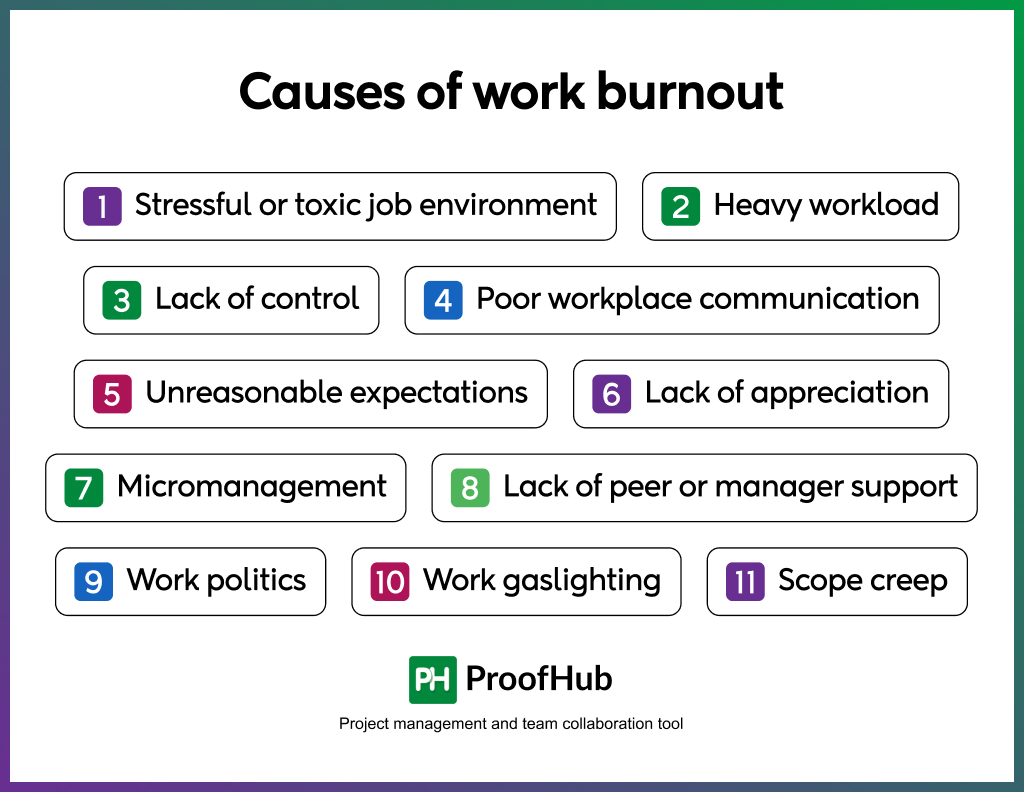
A few of them are:
- stressful or toxic job environment
- heavy workload
- lack of control
- poor workplace communication
- unreasonable expectations
- lack of appreciation
- micromanagement
- lack of peer or manager support
- work politics
- work gaslighting
- scope creep
When we ran a poll on LinkedIn about work burnout, the top response surprisingly wasn’t stress, but rather unrealistic workloads, followed closely by unclear expectations and difficulty achieving work-life balance.
The 5 stages of work burnout
Burnout isn’t instantaneous. It takes time to step out of stress and reach its peak. It can impact you at any stage of your career or profession.
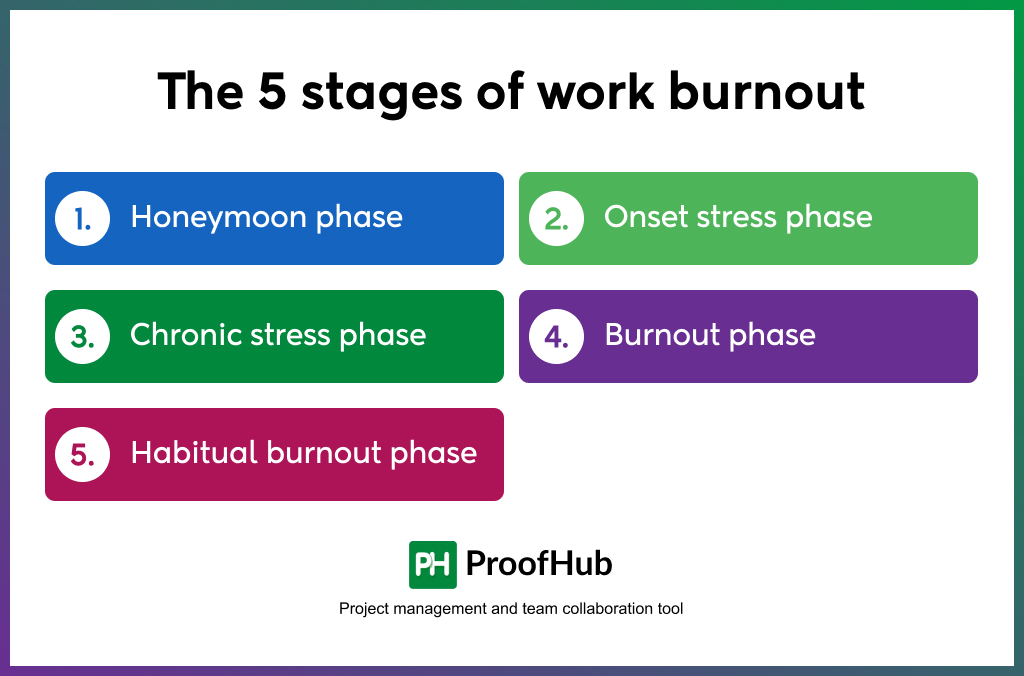
The five series of stages through which burnout progresses are:
1. Honeymoon phase
This is the most happy-go-lucky phase of your professional career. You are most energetic, optimistic, and committed at this point. You are accepting whatever responsibilities are coming your way and putting your best foot forward. The intensity is so high that you don’t mind extending your hours, skipping lunches, or over-committing. But this is the phase where you might start developing some unhealthy patterns for yourself.
2. Onset stress phase
As the name suggests, this is the phase where you see your initial enthusiasm wearing down. As this phase commences, you observe not all but occasional stressful days at work. Some days feel like a breeze, while others demand every ounce of your potential. Make sure to take notice of early warning signs during this period, like fatigue, irritability, anxiety, declining productivity, etc.
3. Chronic stress phase
Here comes the marked transition where shift happens. Occupational stress days become frequent, persistent, and chronic. You might be relying on caffeine shots to get through the days. During this stage, you lack the motivation and become reluctant towards the work coming your way. The intensity of symptoms increases here compared to phase 2. Some possible signs to be wary of are – aggression, resentment, panic, anxiety, procrastination, and more.
4. Burnout phase
This phase comes when you completely become the victim of burnout. You experience all the possible symptoms of burnout – physical, emotional, and mental. The most prominent sign is that you don’t even want to come to the office and fear the working week that is yet on the corner. You don’t stand on what is expected of you and feel consumed and drained all the time.
5. Habitual burnout phase
The final stage, “habitual” or “enmeshment,” is the stage where burnout becomes your default operating mode. That becomes the new normal for you, and you may not even be yourself anymore if you don’t intervene. Chronic mental and physical fatigue, sadness, and depression are some persistent symptoms that prevail.
Prevention and recovery of burnout symptoms
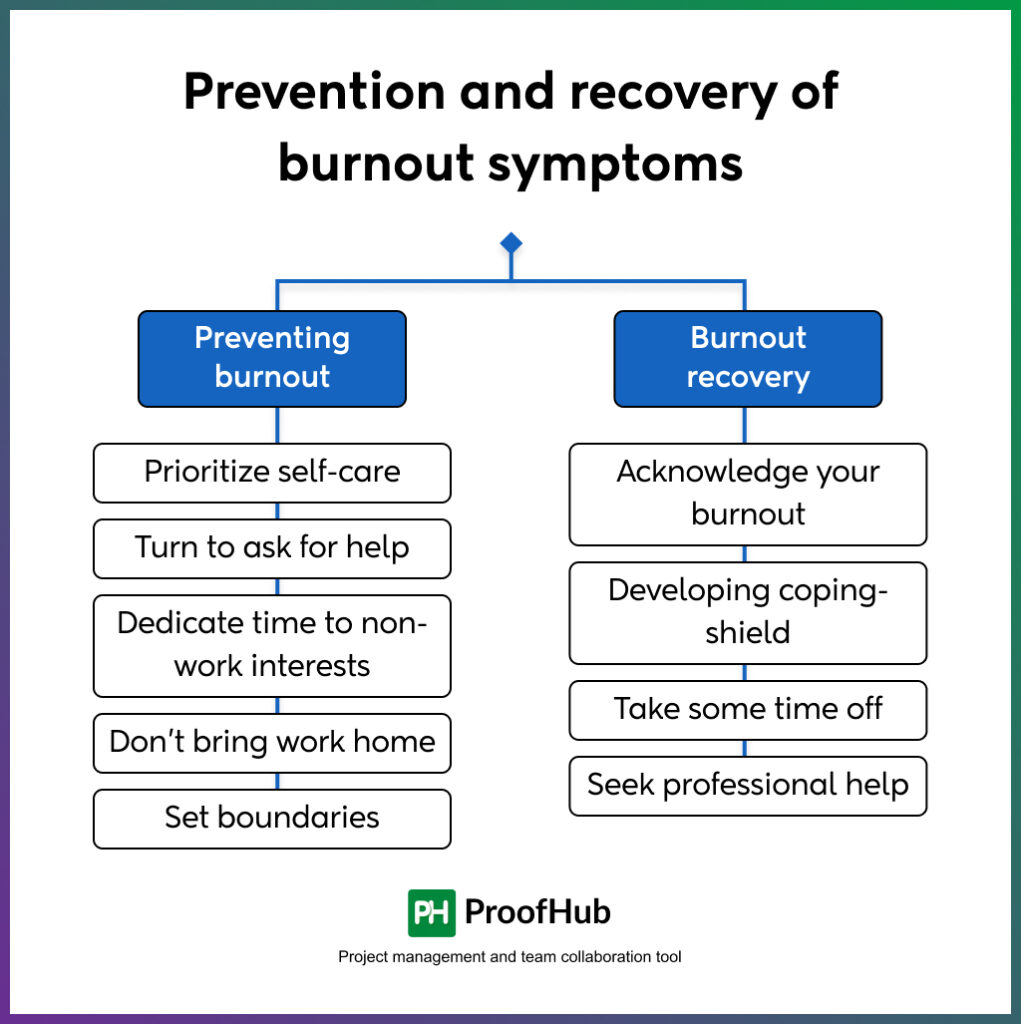
Whether you or your team is showing signs of impending occupational burnout or have already passed the enduring capacity, it’s time to pause. Pushing yourself too hard won’t do any good; it will make things even worse.
Preventing burnout: building a resilient yourself
1. Prioritize self-care
When you start witnessing burnout symptoms in you, start paying attention to your health. With that, I don’t just mean your physical, but mental and emotional health too. You should replenish your energy by adopting various healthy habits, like practicing meditation, exercising, getting enough sleep, eating a healthy diet, etc.
2. Turn to ask for help
Do not shy away from seeking support from your peers or management when you feel drained out to the core. Why so? Because you become clueless in those vulnerable moments and can’t see through what is happening to you. However, involving a trusted one can assist you in addressing and managing the major depressive disorder.
3. Dedicate time to non-work interests
“You have to have something outside of work that helps you de-stress, that helps you focus and helps you relax,”- Dr. Lotte Dyrbye, a physician-scientist who studies burnout at the Mayo Clinic.
Pursuing non-work interests outside work helps you recharge your work battery. Do meditation, read books, binge-watch shows, or engage in hobbies. Find a particular activity you enjoy doing, like painting, trekking, swimming, cooking, or gardening. You can even try out your hands at learning a new language, instrument, or skill.
4. Don’t bring work home
Ensure your beyond working hours do not get consumed by your office work. 60% of US workers confirm a lack of boundaries between work and personal life.
Even if it’s a work email flashing on your phone or a work request from your colleague, resist the urge to be responsive. Be mindful of how you choose to utilize that time. It is for you and your family, and not for work. If you choose not to respect your hours, trust me, no one will. Allow yourself to soak in the relaxation and bounce back rejuvenated the next morning.
5. Set boundaries
Save yourself from over-committing. If you don’t have enough bandwidth or are feeling overwhelmed or exhausted, then let others know. Learn to say no when extra work comes flooding in, demanding your attention. Only when it isn’t a top priority. Because if you keep overloading yourself, you will end up doing nothing instead of everything.
Burnout recovery: taking back your control
6. Acknowledge your burnout
When you find yourself or your team already slipped into the abyss, the first step is to acknowledge your work burnout. Recognize the signs and symptoms that are causing you endless fatigue.
Understand the impact and effect it is imposing on your mental, physical, and emotional health. And that’s necessary because acceptance is the key to helping you take action towards recovery.
7. Developing coping-shield
You can shield yourself from external stressors by developing a thick skin. Skills like time management, organizational management, and cognitive restructuring are essential.
You can strengthen your guarding capabilities by equipping yourself with relaxation techniques like deep breathing exercises, yoga, meditation, etc. Shifting your mindset to focus on the positive and discarding any preconceived assumptions is crucial.
8. Take some time off
If things don’t seem in control or feel like slipping through your hands, it’s better to have or give some downtime. According to a study by Project: TimeOff, an initiative created by the U.S. Travel Association states that 52% left holidays on the table. And that is pretty alarming.
Use your paid vacations and utilize this time to detach yourself from work and invest in your recovery for re-energizing. Take a shorter or longer vacation, be it a couple of days, a week, or two weeks, to bounce back to work in your beast mode.
9. Seek professional help
Confronting burnout for yourself or your team can be pretty demanding and overwhelming at times. There will be times when, despite trying multiple strategies, you will see no improvement. When that happens, you should seek professional intervention.
A therapist or psychologist can help develop coping mechanisms with professional guidance for your organizational culture. With a professional therapist at your rescue, you have a safe space to discuss your vulnerabilities without the fear of judgment.
Long-term consequences of unaddressed burnout
Work burnout, if left unaddressed, can have far-reaching impacts on both employees and organizations. It sieves through fine cracks and lingers on to the extent where even routine tasks seem a struggle.
For individuals, it manifests into symptoms like:
- chronic fatigue
- cynical behavior
- heart diseases
- high blood pressure
- weakened immune system
- depression
- anxiety
- emotionally numb
- social withdrawal
- strained relationships
- cognitive impairments
- increased irritability
- mood swings
- hopelessness
For organizations, neglected burnout translates into
- high turnover rates
- lack of experienced staff
- reduced productivity
- lower work quality
- disengaged workforce
- error-prone output
- negative workplace atmosphere
- low employee morale
- increased absenteeism
- poor job performance
- strained social connection
How can a manager promote a burnout-free environment
Burnout, as it is defined, is not a medical condition — it’s “a manifestation of chronic unmitigated stress,” explained Dr. Lotte Dyrbye, a physician-scientist who studies burnout at the Mayo Clinic.

6 ways to prevent work burnout
Being a manager, you know you have a fair share of a deal in creating a healthy environment. The moment you experience burnout crawling into your work dynamics, switch to these practical tips to build a workforce that is thriving and growing.
1. Create work-life balance
First, eliminate the overwork factor, which is both the reason for and the result of workplace burnout. Establish scheduled hours and ensure employees do not overstretch. No matter whether remote or in-office, draw out a transparent policy that supports outcomes over hours as a performance indicator.
Discover effective work-life balance tips for both your personal and professional well-being
2. Prioritize holistic well-being
Implement programs that prioritize employees’ mental and physical well-being. Empower them to take care of themselves, share their vulnerabilities, and don’t shy away from reaching out. Provide them with health-related training, host stress management sessions, and conduct employee assistance programs.
3. Set realistic expectations
Don’t burden your employees with the load of unrealistic expectations, deadlines, and priorities. Instead, make sure they are given reasonable tasks and have the necessary resources for successful accomplishment. Encourage them to come to you whenever in need of assistance and support.
4. Prioritize open and effective communication
Create a safe space where employees trust you. They don’t hesitate to reach out to you about anything – even about their mental health, too. Have 1:1 sessions and team meetings to discuss mental fatigue, address difficulties, and build confidence. Reflect on these conversations to be responsive to addressing burnout early on. And enhance workplace transparency.
Know the essence of effective communication to foster better collaboration with your team
5. Promote time-offs
Don’t be the manager who takes a count of the times employees take breaks and use their phones. Instead, encourage them to take regular breaks and casual leaves as it dilutes the impacts of work pressure. Learn there is a fine line between necessary and too much. Make them understand the balance so that they respect boundaries.
6. Create a psychologically safe environment
To maintain occupational safety and health, you should mitigate psychological stress in your workplace through psychological intervention. You can do that by creating a psychologically safe environment, which will act as a shield against burnout because it will help your employees find their support system in you.
ProofHub is your best ally in safeguarding your energy and restoring balance to fend off burnout. You can use it to stay on top and gain control of project progress, team workload, and deadlines. Not just that, you can also use the tool to facilitate open communication and provide a centralized platform for seamless collaboration and supporting resources.
Conclusion
Work burnout is no joke, but it doesn’t have to be your reality for life. By understanding and recognizing the signals in you and around you, you can take proactive steps to prevent it.
Don’t just grind yourself into the ground – it’s a dead-end move. Whether you are a manager or an employee, remember that beating burnout is a collective effort. It is only by supporting each other that you can escape from the clutches of burnout and rebound with greater strength.
FAQs
How do you fix burnout at work?
Fixing burnout at work requires major modifications in the work environment. The different ways you can rectify professional burnout are:
- Facilitating open workplace communication
- Providing employee assistance programs
- Promoting breaks and time-offs
- Creating a psychologically safe environment
How do you deal with burnout without quitting your job?
Dealing with burnout is a two-step approach: identifying the root cause and implementing solutions. There are plenty of ways you can mentally reset without quitting your job. Some of these parameters include:
- Acknowledging your burnout
- Talking to your manager
- Seeking support from colleagues
- Setting boundaries
- Prioritizing seld-care
And more.
What is the difference between stress and burnout?
Stress and burnout are somewhere related but entirely different. Stress is a short-term perceived threat or demand that often leads to anxiety. On the other hand, burnout is a negative cycle of emotions that is the repercussion of unchecked and prolonged stress.
How long can burnout last?
According to a Clinical perspective paper on Burnout, stress recovery is possible between a month and three. However, in some cases, it lasts for more than a year, too.
